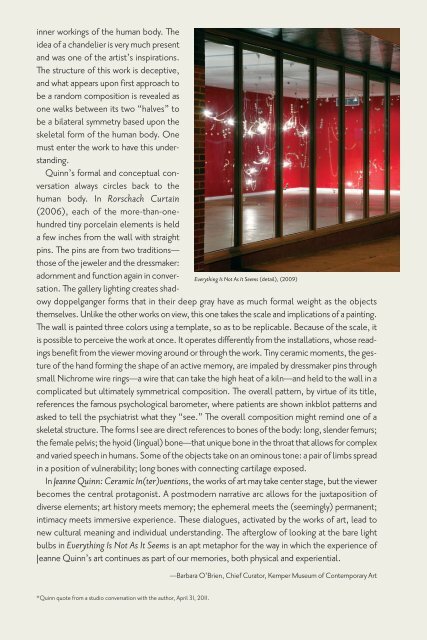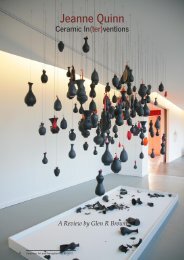view show brochure - Jeanne Quinn
view show brochure - Jeanne Quinn
view show brochure - Jeanne Quinn
You also want an ePaper? Increase the reach of your titles
YUMPU automatically turns print PDFs into web optimized ePapers that Google loves.
inner workings of the human body. The<br />
idea of a chandelier is very much present<br />
and was one of the artist’s inspirations.<br />
The structure of this work is deceptive,<br />
and what appears upon first approach to<br />
be a random composition is revealed as<br />
one walks between its two “halves” to<br />
be a bilateral symmetry based upon the<br />
skeletal form of the human body. One<br />
must enter the work to have this understanding.<br />
<strong>Quinn</strong>’s formal and conceptual conversation<br />
always circles back to the<br />
human body. In Rorschach Curtain<br />
(2006), each of the more-than-onehundred<br />
tiny porcelain elements is held<br />
a few inches from the wall with straight<br />
pins. The pins are from two traditions—<br />
those of the jeweler and the dressmaker:<br />
adornment and function again in conversation.<br />
The gallery lighting creates shad-<br />
Everything Is Not As It Seems (detail), (2009)<br />
owy doppelganger forms that in their deep gray have as much formal weight as the objects<br />
themselves. Unlike the other works on <strong>view</strong>, this one takes the scale and implications of a painting.<br />
The wall is painted three colors using a template, so as to be replicable. Because of the scale, it<br />
is possible to perceive the work at once. It operates differently from the installations, whose readings<br />
benefit from the <strong>view</strong>er moving around or through the work. Tiny ceramic moments, the gesture<br />
of the hand forming the shape of an active memory, are impaled by dressmaker pins through<br />
small Nichrome wire rings—a wire that can take the high heat of a kiln—and held to the wall in a<br />
complicated but ultimately symmetrical composition. The overall pattern, by virtue of its title,<br />
references the famous psychological barometer, where patients are <strong>show</strong>n inkblot patterns and<br />
asked to tell the psychiatrist what they “see.” The overall composition might remind one of a<br />
skeletal structure. The forms I see are direct references to bones of the body: long, slender femurs;<br />
the female pelvis; the hyoid (lingual) bone—that unique bone in the throat that allows for complex<br />
and varied speech in humans. Some of the objects take on an ominous tone: a pair of limbs spread<br />
in a position of vulnerability; long bones with connecting cartilage exposed.<br />
In <strong>Jeanne</strong> <strong>Quinn</strong>: Ceramic In(ter)ventions, the works of art may take center stage, but the <strong>view</strong>er<br />
becomes the central protagonist. A postmodern narrative arc allows for the juxtaposition of<br />
diverse elements; art history meets memory; the ephemeral meets the (seemingly) permanent;<br />
intimacy meets immersive experience. These dialogues, activated by the works of art, lead to<br />
new cultural meaning and individual understanding. The afterglow of looking at the bare light<br />
bulbs in Everything Is Not As It Seems is an apt metaphor for the way in which the experience of<br />
<strong>Jeanne</strong> <strong>Quinn</strong>’s art continues as part of our memories, both physical and experiential.<br />
—Barbara O’Brien, Chief Curator, Kemper Museum of Contemporary Art<br />
*<strong>Quinn</strong> quote from a studio conversation with the author, April 31, 2011.



